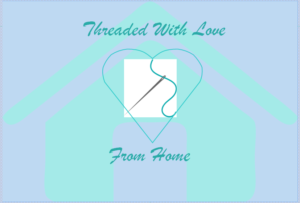
In my last blog I talked about receiving my first ever order for Threaded with Love from Home (TWLFH), in this blog I would like to take you through the process behind the make.
Once I had selected the material and design for the cushions, the first step was to free draw the core shapes for the embroidery onto a piece of squared paper, this ensured that I was able to get the dimensions right for the size of the cushion. I then selected a contrast embroidery thread to match the material I had found.
When quilting any image onto fabric I would always recommend starting by securing the wadding and main fabric together to avoid any movement and challenges further down the line.
Next, I redrew the two images onto the material using a pencil, there are many products available to draw on material, but I prefer good old fashioned pencil, it easily washes off once you have finished a piece and is easy to see whilst sewing. Some of the other products I have tried fade too quickly and this means you end up having to redraw the image multiple times during the embroidery process.
Hand sewing can be daunting, and I am not the world’s greatest at embroidery, however, cross stitch, blanket stitch and stem stitch are all very forgiving and look effective on most fabrics.
Once both images were completed, I then set about transforming the quilted pieces into a cushion. Although most patterns will tell you to tack the edges first and then machine stitch afterwards, I much prefer to use pins and then go straight to machining. I find this allows me more freedom to change my mind or to make minor adjustments during sewing.
One golden rule that is a “must” before heading to the sewing machine is to iron your fabric (on the reverse), this eliminates any wrinkles or creases that could cause the material to not match up/sit correctly. Believe me, there is nothing more frustrating than turning your project through to the right side and finding that a crease has made the finished item look wonky!
I am a fan of zips on cushions for several reasons: –
- They always look tidy
- The do not dig in when you lean on the finished cushion (after all your primary goal is comfort).
- They always wash better in a washing machine.
- The ensure that ta cushion sits well inside the cover.
With the Zip finished and all of the small threads removed, I put the cushion cover through the wash I always wash for the first time on 30 degrees and then allow to dry over a radiator or if we are having a lucky day, out on the line. I love my tumble dryer, but from experience, handmade items are guaranteed to shrink, shift or lose shape if tumble dried (even if the manufacturer states that they won’t!).
If you have anything you would like me to write about in my next blog get in touch through my “contact me” page and I will try my best for you. Alternatively speak to you soon with another project.
